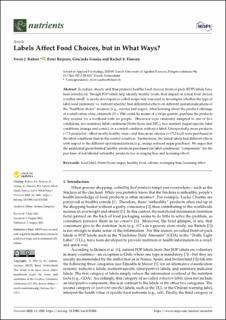Please use this identifier to cite or link to this item:
https://doi.org/10.21256/zhaw-25933| Publication type: | Article in scientific journal |
| Type of review: | Peer review (publication) |
| Title: | Labels affect food choices, but in what ways? |
| Authors: | Kühne, Swen J. Reijnen, Ester Granja, Gracinda Hansen, Rachel S. |
| et. al: | No |
| DOI: | 10.3390/nu14153204 10.21256/zhaw-25933 |
| Published in: | Nutrients |
| Volume(Issue): | 14 |
| Issue: | 15 |
| Page(s): | 3204 |
| Issue Date: | 2022 |
| Publisher / Ed. Institution: | MDPI |
| ISSN: | 2072-6643 |
| Language: | English |
| Subjects: | Food label; Nutri-Score; Sugar; Healthy food; Calorie; Averaging bias; Licensing effect |
| Subject (DDC): | 150: Psychology 613.2: Dietetics |
| Abstract: | To reduce obesity and thus promote healthy food choices, front-of-pack (FOP) labels have been introduced. Though FOP labels help identify healthy foods, their impact on actual food choices is rather small. A newly developed so-called swipe task was used to investigate whether the type of label used (summary vs. nutrient-specific) had differential effects on different operationalizations of the “healthier choice” measure (e.g., calories and sugar). After learning about the product offerings of a small online store, observers (N = 354) could, by means of a swipe gesture, purchase the products they needed for a weekend with six people. Observers were randomly assigned to one of five conditions, two summary label conditions (Nutri-Score and HFL), two nutrient (sugar)-specific label conditions (manga and comic), or a control condition without a label. Unexpectedly, more products (+7.3 products)—albeit mostly healthy ones—and thus more calories (+1732 kcal) were purchased in the label conditions than in the control condition. Furthermore, the tested labels had different effects with respect to the different operationalizations (e.g., manga reduced sugar purchase). We argue that the additional green-labeled healthy products purchased (in label conditions) “compensate” for the purchase of red-labeled unhealthy products (see averaging bias and licensing effect). |
| URI: | https://digitalcollection.zhaw.ch/handle/11475/25933 |
| Fulltext version: | Published version |
| License (according to publishing contract): | CC BY 4.0: Attribution 4.0 International |
| Departement: | Applied Psychology |
| Organisational Unit: | Psychological Institute (PI) |
| Appears in collections: | Publikationen Angewandte Psychologie |
Files in This Item:
| File | Description | Size | Format | |
|---|---|---|---|---|
| 2022_Kuehne-etal_Labels-affect-food-choices_nutrients.pdf | 2.71 MB | Adobe PDF |  View/Open |
Show full item record
Kühne, S. J., Reijnen, E., Granja, G., & Hansen, R. S. (2022). Labels affect food choices, but in what ways? Nutrients, 14(15), 3204. https://doi.org/10.3390/nu14153204
Kühne, S.J. et al. (2022) ‘Labels affect food choices, but in what ways?’, Nutrients, 14(15), p. 3204. Available at: https://doi.org/10.3390/nu14153204.
S. J. Kühne, E. Reijnen, G. Granja, and R. S. Hansen, “Labels affect food choices, but in what ways?,” Nutrients, vol. 14, no. 15, p. 3204, 2022, doi: 10.3390/nu14153204.
KÜHNE, Swen J., Ester REIJNEN, Gracinda GRANJA und Rachel S. HANSEN, 2022. Labels affect food choices, but in what ways? Nutrients. 2022. Bd. 14, Nr. 15, S. 3204. DOI 10.3390/nu14153204
Kühne, Swen J., Ester Reijnen, Gracinda Granja, and Rachel S. Hansen. 2022. “Labels Affect Food Choices, but in What Ways?” Nutrients 14 (15): 3204. https://doi.org/10.3390/nu14153204.
Kühne, Swen J., et al. “Labels Affect Food Choices, but in What Ways?” Nutrients, vol. 14, no. 15, 2022, p. 3204, https://doi.org/10.3390/nu14153204.
Items in DSpace are protected by copyright, with all rights reserved, unless otherwise indicated.